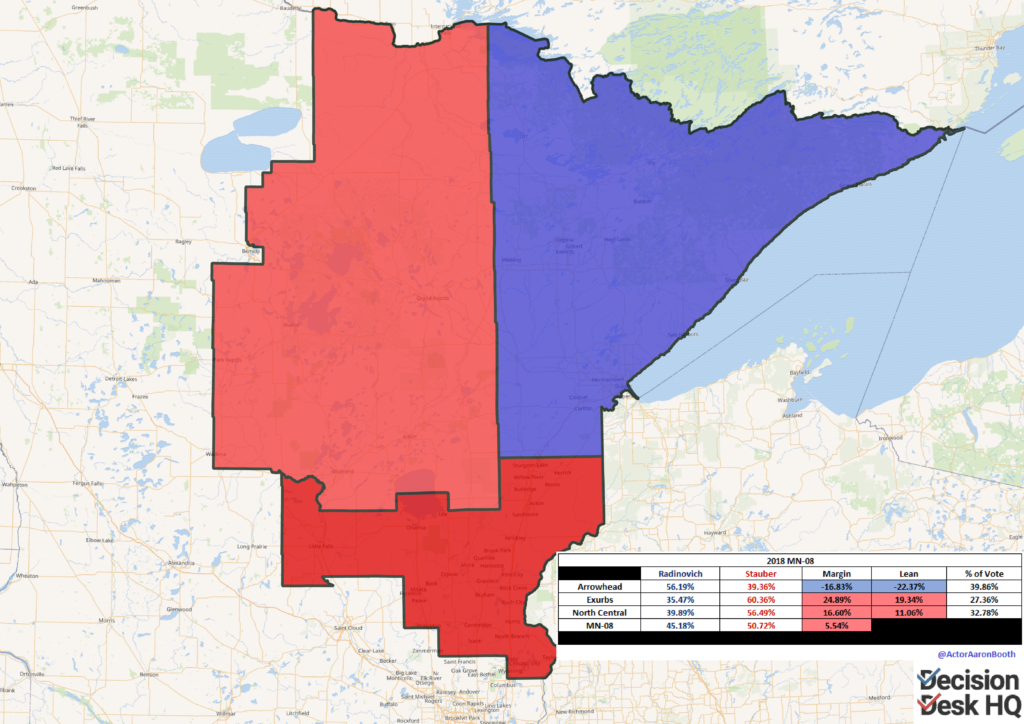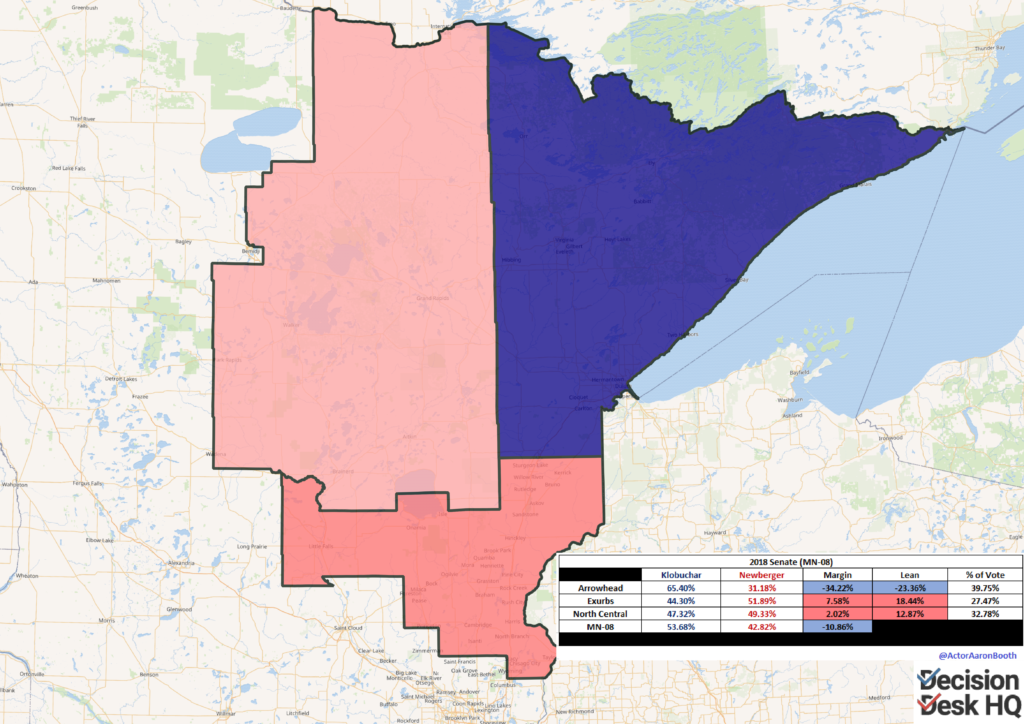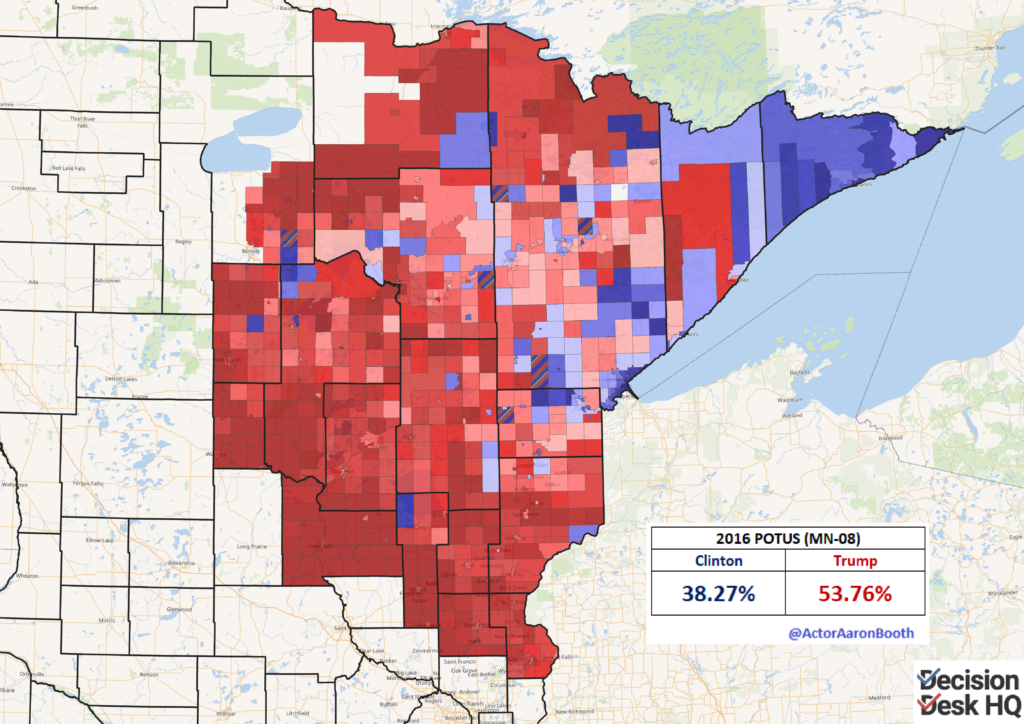

In 2018, the Republican party picked up two Congressional districts despite the “blue wave.” Both of those pickups came from open seats in Minnesota. Last week I discussed the tightening MN-01 race, and this week attention turns to the less competitive MN-08. Unlike the first district, the 8th features a fairly generic Republican incumbent in Pete Stauber, who (aside from also being on the Delta flight after COVID exposure) doesn’t have the baggage of Hagedorn. The DFL nominee is a fairly generic Democrat as well in former Baxter City Council Member Quinn Nystrom.
Minnesota’s Eight Congressional district contains a swath of ancestrally Democratic territory including the Iron Range. While the Iron Range is not the bastion of DFL strength as it has been in the past, it is still fairly winnable for Democrats. Duluth has also remained fairly blue. What is hurting Democrats most in the district are the counties outside of the four county arrowhead. The exurbs of the Twin Cities and St Cloud are quite red as well as the rural north central region of the state. Pockets of Native American population and the hospitality industry at various travel destinations present a bit of a buffer for the DFL to offset some of the GOP’s gains, however the only way to flip the district back is going to be winning back enough of those rural non-college whites in north central Minnesota.
The Iron Range itself has been changing over the past decades as production has dipped, automation has increased, mines have closed and population has dwindled. School districts have consolidated in once heavily Democratic and unionized mining communities across the range. What has replaced the mining communities as the DFL base in the district is the tourism and hospitality industry. From Lake Superior to the boundary waters, to state forests to significant casinos in Hinckley and Onamia.


Klobuchar’s 2018 performance in the district while Stauber was flipping the district gives a bit of a potential roadmap for future DFL success. While she still lost the non-arrowhead portions of the district, she was able to keep the margins close, particularly in the north central region. She was also able to run up the score in the arrowhead region which she won by 34 points. Radinovich only carried the region by half of Klobuchar’s margin.


The DFL last held this seat in 2016 when Rick Nolan won a narrow reelection battle against Stewart Mills (yes, associated with Mills Fleet Farm). The Nolan coalition was mostly a scaled down version of the one Klobuchar had in 2018. While Nolan’s final victory as narrow, it appears more impressive considering he outran Clinton by double digits.


Clinton lost ground pretty much everywhere, and only narrowly hit double digits in the once deep blue arrowhead region. The under-performance in the arrowhead and Trump’s significant margins in the rest of the district helped Trump flip this district from Obama in 2012 to Trump in 2016. The good news for the DFL is that Biden is likely to narrow the margin back down to the single digits. Some reversion to the mean among non-college rural white voters will likely not be enough to flip the district back, but it will certainly pad his margin in the state.
A recent indication that Democrats feel optimistic here is that Biden has now endorsed Nystrom for Congress. This would seem to suggest that the campaigns do not feel that Biden is going to be a particular drag on down-ballot Democrats in districts such as the 8th. That may not suggest that Biden is on path to win the district, but if he were to get the district down to a 5-point margin, a Biden endorsement could help move the needle if Nystrom was previously closer to Clinton’s 2016 margin. If Democrats wind up in more of a super-landslide territory as some polling suggests, districts like MN-08, SC-02 and NE-01 could surprise some observers in how close they end up. Despite how close they may finish, getting the Democratic challenger over the finish line in any of those districts is likely a bridge too far.
Democrats have a vested interest in this district aside from attempting to flip it back. With redistricting looming, it is unknown how much of the district could end up in a district with some more Democratic-friendly suburbs. There are also a series of state legislative seats that the party continues to have a strong hold over. Finally, whether the GOP considers Stauber a viable statewide candidate in 2022, 2024 or 2026 may very well depend on his ability to solidify his hold on this former Democratic stronghold.
Aaron Booth (@ActorAaronBooth) is a contributor to Decision Desk HQ.